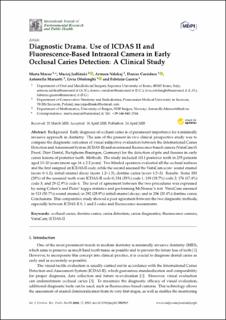| dc.contributor.author | Mazur, Marta | |
| dc.contributor.author | Jedliński, Maciej | |
| dc.contributor.author | Ndokaj, Artnora | |
| dc.contributor.author | Corridore, Denise | |
| dc.contributor.author | Maruotti, Antonello | |
| dc.contributor.author | Ottolenghi, Livia | |
| dc.contributor.author | Guerra, Fabrizio | |
| dc.date.accessioned | 2021-08-05T07:54:21Z | |
| dc.date.available | 2021-08-05T07:54:21Z | |
| dc.date.created | 2020-12-13T21:40:15Z | |
| dc.date.issued | 2020 | |
| dc.identifier.issn | 1661-7827 | |
| dc.identifier.uri | https://hdl.handle.net/11250/2766350 | |
| dc.description.abstract | Background: Early diagnosis of occlusal caries is of paramount importance for a minimally invasive approach in dentistry. The aim of the present in vivo clinical prospective study was to compare the diagnostic outcomes of visual subjective evaluation between the International Caries Detection and Assessment System (ICDAS-II) and an intraoral fluorescence-based camera (VistaCam iX Proof, Dürr Dental, Bietigheim-Bissingen, Germany) for the detection of pits and fissures in early caries lesions of posterior teeth. Methods: The study included 1011 posterior teeth in 255 patients aged 13–20 years (mean age 16 ± 2.2 years). Two blinded operators evaluated all the occlusal surfaces and the first assigned an ICDAS-II code, while the second assessed the VistaCam score: sound enamel (score 0–1.2); initial enamel decay (score 1.2–1.5); dentine caries (score 1.5–3). Results: Some 283 (28%) of the assessed teeth were ICDAS-II code 0; 334 (33%) code 1; 189 (18.7%) code 2; 176 (17.4%) code 3; and 29 (2.9%) code 4. The level of agreement between the two procedures was expressed by using Cohen’s and Fleiss’ kappa statistics and performing McNemar’s test. VistaCam assessed in 513 (50.7%) sound enamel; in 292 (28.9%) initial enamel decay; and in 206 (20.4%) dentine caries. Conclusions: This comparative study showed a poor agreement between the two diagnostic methods, especially between ICDAS-II 0, 1 and 2 codes and fluorescence assessments. | en_US |
| dc.language.iso | eng | en_US |
| dc.publisher | MDPI | en_US |
| dc.rights | Navngivelse 4.0 Internasjonal | * |
| dc.rights.uri | http://creativecommons.org/licenses/by/4.0/deed.no | * |
| dc.title | Diagnostic drama. Use of ICDAS II and fluorescence-based intraoral camera in early occlusal caries detection: A clinical study | en_US |
| dc.type | Journal article | en_US |
| dc.type | Peer reviewed | en_US |
| dc.description.version | publishedVersion | en_US |
| dc.rights.holder | Copyright 2020 The Authors | en_US |
| dc.source.articlenumber | 2937 | en_US |
| cristin.ispublished | true | |
| cristin.fulltext | original | |
| cristin.qualitycode | 1 | |
| dc.identifier.doi | 10.3390/ijerph17082937 | |
| dc.identifier.cristin | 1859248 | |
| dc.source.journal | International Journal of Environmental Research and Public Health (IJERPH) | en_US |
| dc.identifier.citation | International Journal of Environmental Research and Public Health (IJERPH). 2020, 17(8), 2937 | en_US |
| dc.source.volume | 17 | en_US |
| dc.source.issue | 8 | en_US |

